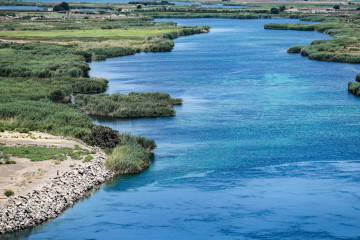

In the early weeks of November world leaders convened in Glasgow to accelerate the global response to the threats of climate change. More than three thousand miles away, along the Euphrates River in northeast Syria and Iraq, the threat had already arrived. The Euphrates has seen historically low levels since the beginning of this year, culminating in a drought hitting Syria’s main agricultural region. The crisis has put more than 12 million people across Syria and Iraq at risk of losing access to water, food, and electricity, as well as exposing them to deadly waterborne disease outbreaks.
The drought
In the short term, authorities in the Kurdish-led Autonomous Administration of North and East Syria (AANES), otherwise known as Rojava, report that last year’s wheat surplus will cover the 2021 deficit. But this season’s poor harvest, which yielded just one-third of the previous year, will likely carry over into the next, as low crop yields turn over to limited availability of seed for the next season.
"A 2021 report from Chatham House finds that in less than 20 years, upwards of 700 million people may be exposed to droughts lasting as long as six months, with those in the Middle East and North Africa being exposed to the most water stress by the middle of this century"
An October report from the UN Food and Agriculture Organization (FAO) confirms that the lower harvest yields may be felt for at least the next two years.
Nearly half of Syrians rely on agriculture for their livelihoods in a country where 65 percent of water resources come from rainfall. Beyond this season’s cycle, the Euphrates and Tigris river basins are projected to experience a seven to 14 percent drop in average rainfall over the coming years. The land, and those who rely on it for their livelihoods, will remain extremely vulnerable to climate shocks like drought or flooding.
Water access
Syria’s northeast is primarily controlled by the US-backed Syrian Democratic Forces (SDF), a Kurdish-majority military unit established in 2015 to fight the Islamic State group and extremist forces in Syria.
The water situation has been exacerbated by infrequent access to water coming from the Alouk water station, which has been under Turkish control since the October 2019 offensive (dubbed Operation Peace Spring) in the northeast.
Since then, Turkish-backed groups are reported to have built three dams in northeast Syria, cutting off the Khabur River from nearby Hasakah. Over the past two years, analysis from PAX for Peace finds, the Ankara-backed Syrian National Army (SNA) disrupted water flow from the Alouk Water Station to nearby cities, leaving nearly a million people without water access.
Beyond the current crisis
In the coming years, the drought of this scale may well become the norm in the region. A 2021 report from Chatham House finds that in less than 20 years, upwards of 700 million people may be exposed to droughts lasting as long as six months, with those in the Middle East and North Africa being exposed to the most water stress by the middle of this century.
Between floods, wildfires, and earthquakes, climate disasters are responsible for 341,000 new displacements across the region in 2020, according to research from the Internal Displacement Monitoring Centre and the Norwegian Refugee Council.
In that same year, the combination of conflict and weather disasters saw 40.5 million new internal displacements across 149 countries, 25,000 alone coming from within Syria.
So, what can be done? Dr Mohammed Mahmoud, Director of the Climate and Water Program at the Middle East Institute, outlines two main response tracks: mitigation and adaptation. While high-level meetings like those addressed at COP26 tend to address mitigation options, adaptation is something that can be utilised at the local level.
Community actions like water conservation may not solve water insecurity or the broader climate change challenge, but they can mitigate the impact on a local population.
"This drought is a cruel reminder that the impacts of climate change are not distributed evenly, and those least responsible for raising CO2 emissions will feel its effects most acutely"
At the state level, extreme heat and water insecurity must be at the forefront of climate adaptation efforts in the wider region, where most countries are at risk of facing extreme water stress.
On the horizon
The latest report from the UN Intergovernmental Panel on Climate Change (IPCC) laid out what to expect without human intervention. The past four decades have been successively warmer than any other before 1850. Last year was the second warmest in history since 1850, and the global surface temperature will continue to rise.
In Syria, precipitation analysis conducted by the FAO between 1980 and 2021 predicts that dry regions can expect to experience drought every three years, meaning this year’s catastrophe may well become the norm.
This drought is a cruel reminder that the impacts of climate change are not distributed evenly, and those least responsible for raising CO2 emissions will feel its effects most acutely.
Tabitha Sanders is a Washington-based freelance journalist. Her writing has appeared in The Washington Monthly, where she covered US foreign policy in the Middle East.
Follow her on Twitter: @thistabithahope
![Aid groups and engineers are warning of a looming humanitarian disaster in northeast Syria, where plummeting water levels at hydroelectric dams since January are threatening water and power cutoffs for millions amidst the coronavirus pandemic and economic crisis [Getty Images]](/sites/default/files/styles/medium_16_9/public/2021-12/GettyImages-1234950696.jpg?h=199d8c1f&itok=RTojK1xE)




 Follow the Middle East's top stories in English at The New Arab on Google News
Follow the Middle East's top stories in English at The New Arab on Google News


